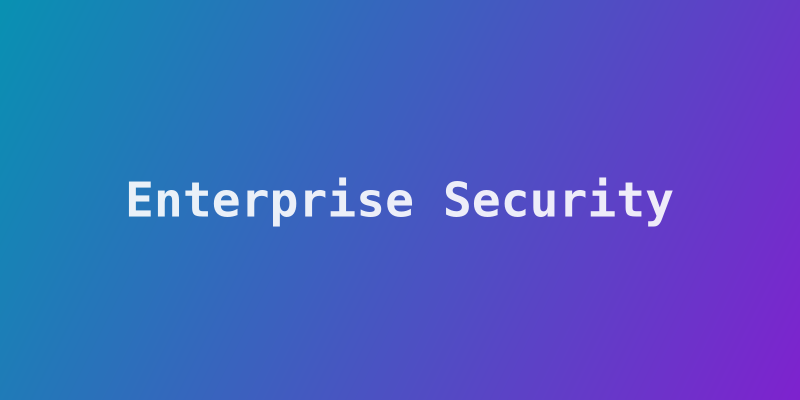Enterprise Security in the Digital Age

In today's interconnected digital landscape, enterprise security has become more critical and complex than ever before. As organizations embrace digital transformation, cloud computing, and remote work, the attack surface has expanded dramatically, requiring a comprehensive and adaptive approach to cybersecurity.
The Modern Threat Landscape
Today's cybersecurity threats are more sophisticated and persistent than ever:
Advanced Persistent Threats (APTs): Nation-state actors and organized cybercriminal groups conduct long-term, targeted attacks against specific organizations.
Ransomware Evolution: Modern ransomware attacks combine data encryption with data exfiltration, creating double extortion scenarios.
Supply Chain Attacks: Attackers target third-party vendors and software dependencies to gain access to multiple organizations.
Cloud Security Challenges: Misconfigurations, inadequate access controls, and shared responsibility models create new vulnerabilities.
Zero Trust Architecture
The traditional perimeter-based security model is no longer sufficient. Zero Trust assumes that threats exist both inside and outside the network:
- Verify Explicitly: Always authenticate and authorize based on all available data points.
- Use Least Privilege Access: Limit user access with just-in-time and just-enough-access principles.
- Assume Breach: Minimize blast radius and segment access to prevent lateral movement.
Identity and Access Management (IAM)
Strong identity management forms the foundation of enterprise security:
Multi-Factor Authentication (MFA): Implement MFA across all systems and applications to prevent credential-based attacks.
Privileged Access Management (PAM): Secure, monitor, and manage privileged accounts and access to critical systems.
Identity Governance: Implement automated provisioning, deprovisioning, and access reviews to maintain proper access controls.
Application Security
Securing applications throughout the development lifecycle is crucial:
Secure Development Lifecycle (SDLC): Integrate security practices into every phase of software development.
Static and Dynamic Analysis: Use automated tools to identify vulnerabilities in code and running applications.
API Security: Implement proper authentication, authorization, and rate limiting for APIs.
Container Security: Secure container images, runtime environments, and orchestration platforms.
Data Protection and Privacy
Protecting sensitive data requires a multi-layered approach:
- Data Classification: Identify and classify data based on sensitivity and regulatory requirements.
- Encryption: Implement encryption at rest, in transit, and in use for sensitive data.
- Data Loss Prevention (DLP): Monitor and prevent unauthorized data exfiltration.
- Privacy by Design: Build privacy considerations into systems and processes from the ground up.
Cloud Security Best Practices
As organizations migrate to the cloud, new security considerations emerge:
Shared Responsibility Model: Understand the division of security responsibilities between cloud providers and customers.
Configuration Management: Implement automated tools to detect and remediate misconfigurations.
Cloud Security Posture Management (CSPM): Continuously monitor cloud environments for security risks and compliance violations.
Cloud Access Security Broker (CASB): Gain visibility and control over cloud application usage and data movement.
Incident Response and Recovery
Despite best efforts, security incidents will occur. Preparation is key:
Incident Response Plan: Develop and regularly test comprehensive incident response procedures.
Threat Hunting: Proactively search for indicators of compromise and advanced threats.
Forensic Capabilities: Maintain the ability to investigate and analyze security incidents.
Business Continuity: Ensure critical business functions can continue during and after security incidents.
Compliance and Governance
Meeting regulatory requirements while maintaining security effectiveness:
- Regulatory Frameworks: Understand and implement requirements from GDPR, HIPAA, SOX, and other relevant regulations.
- Security Metrics: Establish KPIs and metrics to measure security program effectiveness.
- Risk Management: Implement formal risk assessment and management processes.
- Third-Party Risk: Assess and manage security risks from vendors and partners.
Emerging Technologies and Future Considerations
Stay ahead of evolving security challenges:
Artificial Intelligence and Machine Learning: Leverage AI/ML for threat detection, behavioral analysis, and automated response.
Quantum Computing: Prepare for the impact of quantum computing on current cryptographic methods.
IoT Security: Address the unique challenges of securing Internet of Things devices and networks.
5G Security: Understand the security implications of 5G network deployment.
Building a Security-First Culture
Technology alone cannot solve security challenges—human factors are equally important:
Security Awareness Training: Regularly educate employees about current threats and security best practices.
Phishing Simulation: Conduct regular phishing exercises to test and improve employee awareness.
Security Champions: Identify and train security advocates within different business units.
Continuous Improvement: Foster a culture of continuous learning and adaptation to evolving threats.
Enterprise security in the digital age requires a holistic approach that combines advanced technology, robust processes, and a security-conscious culture. Organizations that invest in comprehensive security programs will be better positioned to protect their assets, maintain customer trust, and achieve their business objectives in an increasingly digital world.
Alex Thompson
Senior Software Engineer at Vintorr with expertise in cloud-native technologies and enterprise software development. Passionate about sharing knowledge and helping teams build better software.